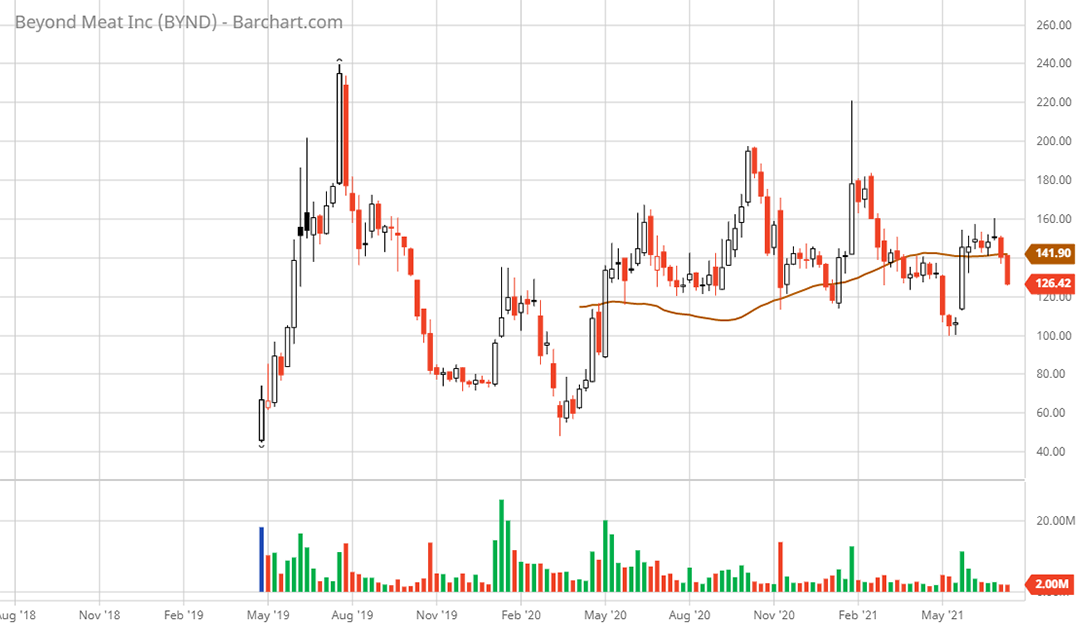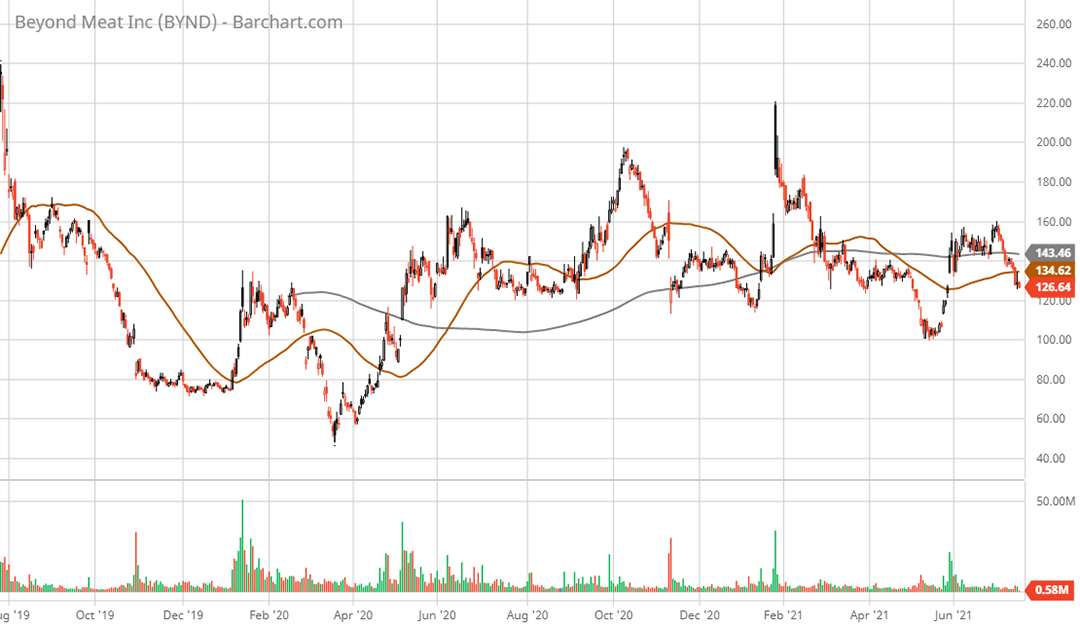Risk/Reward Rating: Negative
Beyond Meat builds fake meat by extracting protein from peas, beans, rice, and other plant stock materials. The company separates plant-based proteins from the fibers via an industrial process and weaves the proteins into the shape of common meat products such as burgers, sausages, meatballs, and chicken tenders. Beyond Meat then uses chemicals and other materials to add the taste, texture, and sensory attributes of real meat products.
The company experienced rapid revenue growth in recent years but is now hitting a soft spot in the marketplace. For example, sales grew 239% in 2019 and decelerated rapidly to 37% growth in 2020. In the first quarter of 2021, sales growth slowed further to only 11%. The company attributes much of the slowdown to the onset of COVID and its impact on the foodservice and quick service restaurant industries (non-grocery retail sales).
The restaurant and food service channel saw sales decline from $153 million in 2019 to $106 million in 2020. To compensate for the declining sales, the company offered lower prices and incentives to retail (grocery) channel partners in an attempt to spur market acceptance. Sales in this channel grew 106% in 2020 at the expense of reduced profitability. The loss for 2020 was $52.6 million compared to a loss of $12.4 million in 2019.
The profit margin opportunity in the retail channel is much reduced compared to the restaurant industry, which creates a cloud of uncertainty over Beyond Meat’s business prospects. Much of the reduced profitability is due to the lower margin nature of direct retail sales. This channel will also require a much greater marketing investment in order to generate brand equity.
Making matters worse, sales in the retail channel grew 28% in Q1 2021 compared to 106% for 2020. The foodservice segment continued to contract posting a 26% decline in sales suggesting that market acceptance may have been a factor in addition to COVID. Losses also accelerated in the first quarter to $24.6 million versus $52.6 million for the entire year in 2020.
Management provided Q2 2021 guidance for sales but was unable to provide guidance for the full year due to the uncertainty around demand. Given the lack of profitability and cash flow, a valuation multiple on sales is the only option. Based on an extrapolation of Q1 2021 sales and Q2 estimates, Beyond Meat is trading at 15x 2021 estimated sales. This multiple of sales is well outside historical market norms and remains highly uncertain.
Technical backdrop: Beyond Meat began trading in April of 2019 in the $50 area and experienced a speculative frenzy up to the $240 range over the course of three months. The stock has been in a sideways pattern for over a year and is currently beneath the 50-week moving average which stands at $142 (brown line on 3-year weekly chart).
Additionally, the 50-day moving average (brown line on 2-year daily chart) is beneath the 200-day moving average (grey line on 2-year daily chart) suggesting that the primary trend is down, which is in line with the fundamental trends.
Technical resistance: The $140 area stands as resistance and is the broken support level from the initial speculative blowoff after the IPO in 2019 and is at the 50-week moving average.
Technical support: The $115 area served as support more recently and was breached in May of this year when the stock found support at $100. The next lower support levels are $80 and then $60. Given the fundamental deterioration, these lower levels are likely to be tested.
Price as of report date 7-16-21: $129
Beyond Meat Investor Relations Website: Beyond Meat Investor Relations
All data in this report is compiled from the Beyond Meat investor relations website and SEC filings, and where applicable publicly available information regarding consensus earnings estimates.



